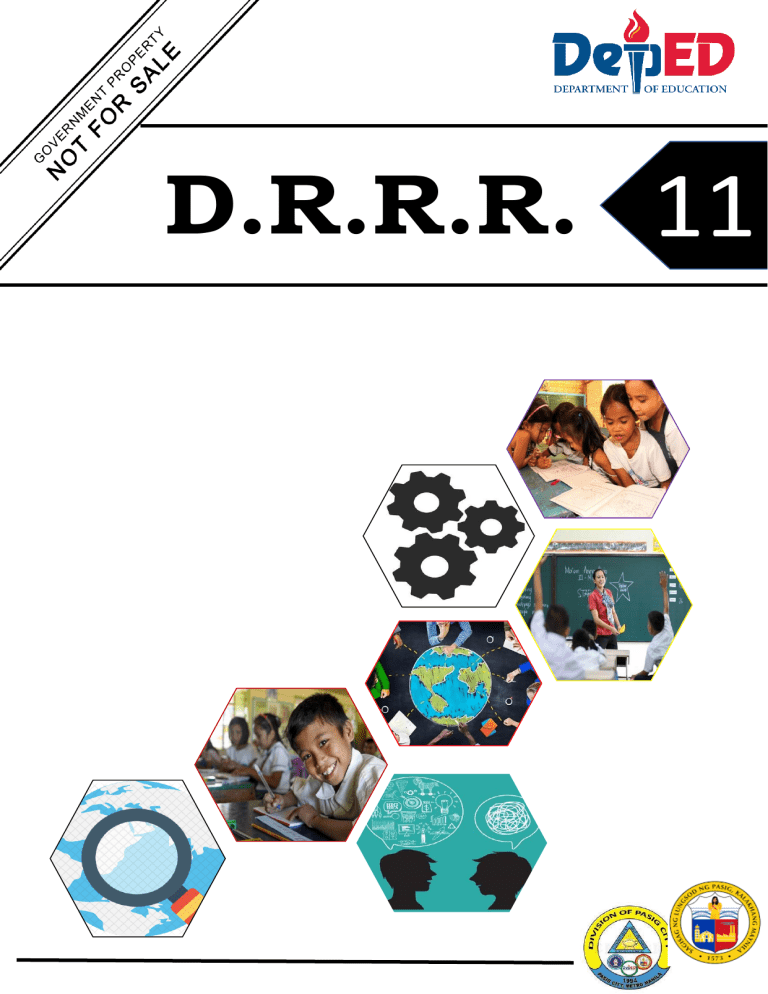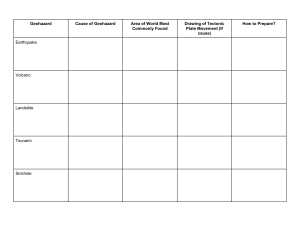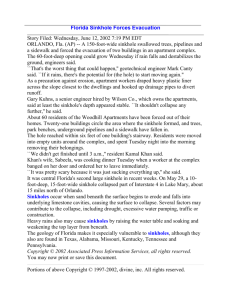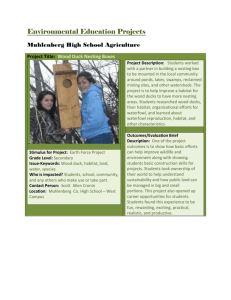
D.R.R.R. 11 Disaster Response and Risk Reduction – Grade 11 Quarter 4 – Module 1: Geological Hazards First Edition, 2020 Republic Act 8293, Section 176 states that no copyright shall subsist in any work of the Government of the Philippines. However, prior approval of the government agency or office wherein the work is created shall be necessary for the exploitation of such work for a profit. Such agency or office may, among other things, impose as a condition the payment of royalties. Borrowed materials (i.e., songs, stories, poems, pictures, photos, brand names, trademarks, etc.) included in this module are owned by their respective copyright holders. Every effort has been exerted to locate and seek permission to use these materials from their respective copyright owners. The publisher and authors do not represent nor claim ownership over them. Published by the Department of Education - Schools Division of Pasig City Development Team of the Self-Learning Module Writer: John Paul B. Aparato Editor: Melvina S. Tarcena Reviewers: Melvina S. Tarcena Illustrator: Layout Artist: Micaelle Lauren V. Tenorio Management Team: Ma. Evalou Concepcion A. Agustin OIC-Schools Division Superintendent Carolina T. Revera, CESE OIC-Assistant Schools Division Superintendent Manuel A. Laguerta, EdD Chief, Curriculum Implementation Division Education Program Supervisors Librada L. Agon EdD (EPP/TLE/TVL/TVE) Liza A. Alvarez (Science/STEM/SSP) Bernard R. Balitao (AP/HUMSS) Joselito E. Calios (English/SPFL/GAS) Norlyn D. Conde EdD (MAPEH/SPA/SPS/HOPE/A&D/Sports) Wilma Q. Del Rosario (LRMS/ADM) Ma. Teresita E. Herrera EdD (Filipino/GAS/Piling Larang) Perlita M. Ignacio PhD (EsP) Dulce O. Santos PhD (Kindergarten/MTB-MLE) Teresita P. Tagulao EdD (Mathematics/ABM) Printed in the Philippines by the Department of Education – Schools Division of Pasig City D.R.R.R. 11 Quarter 4 Self-Learning Module1 Geological Hazards Introductory Message For the Facilitator: Welcome to the Disaster Response and Risk Reduction – Grade 11 and SelfLearning Module on Geological Hazards This Self-Learning Module was collaboratively designed, developed, and reviewed by educators from the Schools Division Office of Pasig City headed by its Officer-in-Charge Schools Division Superintendent, Ma. Evalou Concepcion A. Agustin, in partnership with the City Government of Pasig through its mayor, Honorable Victor Ma. Regis N. Sotto. The writers utilized the standards set by the K to 12 Curriculum using the Most Essential Learning Competencies (MELC) in developing this instructional resource. This learning material hopes to engage the learners in guided and independent learning activities at their own pace and time. Further, this also aims to help learners acquire the needed 21st-century skills especially the 5 Cs, namely: Communication, Collaboration, Creativity, Critical Thinking, and Character while taking into consideration their needs and circumstances. In addition to the material in the main text, you will also see this box in the body of the module: Notes to the Teacher This contains helpful tips or strategies that will help you in guiding the learners. As a facilitator, you are expected to orient the learners on how to use this module. You also need to keep track of the learners' progress while allowing them to manage their learning. Moreover, you are expected to encourage and assist the learners as they do the tasks included in the module. For the Learner: Welcome to the Disaster Response and Risk Reduction Self-Learning Module on Geological Hazard! This module was designed to provide you with fun and meaningful opportunities for guided and independent learning at your own pace and time. You will be enabled to process the contents of the learning material while being an active learner. This module has the following parts and corresponding icons: Expectations - This points to the set of knowledge and skills that you will learn after completing the module. Pretest - This measures your prior knowledge about the lesson at hand. Recap - This part of the module provides a review of concepts and skills that you already know about a previous lesson. Lesson - This section discusses the topic in the module. Activities - This is a set of activities that you need to perform. Wrap-Up - This section summarizes the concepts and application of the lesson. Valuing - This part integrates a desirable moral value in the lesson. Posttest - This measures how much you have learned from the entire module. EXPECTATIONS This module is about the geological hazards in your daily life. After going through this module, you are expected to: 1. compare Rain-induced landslide and Sinkhole; 2. create a timeline of a geological event; and 3. suggest ways in educating other people in geological hazards. PRETEST DIRECTIONS: Circle the best answer for each of the following questions. 1. It is defined as the movement of rock debris or earth down the slope. A. earthquake B. forest fire C. landslide D. tsunami 2. Extreme natural events in the crust of the earth that pose a threat to life and property. A. geological hazard B. hydrometeorological hazard C. landslide hazard D. tsunami hazard 3. A topographic depression formed when underlying limestone bedrock is dissolved by groundwater A. Cave B. Landslide C. Ground break D. Sinkhole 4. The following are examples of geological hazards except? A. earthquake B. landslide C. sinkhole D. hurricane 5. A type of rock that dissolve and cause a sinkhole A. Cement B. Limestone C. Marble D. Sand RECAP https://www.independent.co.uk/voices/taal-volcano-eruption-disaster-philippines-mental-health-a9284361.html FIGURE 1: A resident evacuating after the taal volcano erupts Taal volcano erupted on January 12, 2020, it is 43 years after its previous eruption in 1977 it was a devastated having 160,000 evacuees in Batangas affected in the volcanic eruption and 39 people have recorded death during this disaster. 1. How do you define a volcanic eruption? 2. Cite an example of the “positive effect of eruption”? 3. What are the precautionary measures that you do with your family before, during, and after a volcanic eruption? LESSON Geological hazards are defined as extreme natural events in the crust that will create a treat for humanity or any living things. And some examples of these geological hazards are earthquakes, volcanic eruptions, and more. But there are more geological hazards or other geological hazards namely landslide and sinkhole that we will tackle this lesson. FIGURE 2: Rainfall induced Landslide https://blogs.agu.org/landslideblog/2018/09/21/naga-city-landslide-1/ FIGURE 3: Sinkhole https://www.sott.net/article/300725-5-sinkholes-discovered-in-Negros-OrientalPhilippines How do you describe the pictures above? Landslide is the movement of debris rocks or any particles in the earth in the downslope. And one of the common examples of a landslide is the “rainfall-induced landslide Rainfall-induced landslide is a type of landslide which comes with water in it so aside from debris and rocks it also has water due to heavy RAINFALL. The sinkhole is a naturally occurring geological hazard below the surface that collapse eventually some geologist called it “karst terrain” a specific type of terrain that is from due to dissolving of rock beneath the surface. The most common type of rock that is dissolved in this is limestone. There are major types of a sinkhole and they are: Solution sinkhole- it is the most common sinkhole it formed when the soil is very thin on the surface and exposing the bedrock once it starts to rain the soil are carried out and eventually leaving a hole. Cover collapse sinkhole- the most dangerous type of all the sinkholes happened when water penetrates in the topsoil going to the limestone and dissolve it eventually until the surface collapse. Cover subsidence sinkhole- most common with a surface that semipermeable for example is sand when the limestone is dissolved below the surface due to rain particles are eventually moved downward to replace the space of a limestone. ACTIVITIES ACTIVITY 1 Complete the Venn diagram below by defining the two terms then, identify its similarities and difference. ACTIVITY 2 DIRECTIONS: Create a timeline on the following event of the sinkhole in the Philippines Manila city sinkhole June 08, 2010 Badian Cebu Sinkhole April 29, 2017 Baguio City Sinkhole June 08, 2015 Benguet Sinkhole August 02, 2016 Negros oriental Sinkhole August 22, 2015 What do you think is the reason why this place has a sinkhole? What month do you think is prone to a sinkhole, what do you think is the reason Why? ACTIVITY 3 DIRECTIONS: Complete the crossword puzzle below. Across 1. Natural occurring geological hazards below the surface that collapse eventually some geologist called it “karst terrain” 2. The movement of debris rocks or any particles in the earth in the downslope. 3. A type of rock that dissolves in the process of sinkhole 4. Factors affecting sinkhole and landslide Down 1. The most common sinkhole it formed when the soil is very thin on the surface and exposing the bedrock WRAP-UP DIRECTIONS: identify what type of sinkhole are the following pictures and give a short explanation 1. 2. 3. VALUING DIRECTIONS: Read the questions carefully and confine your responses to an analysis of the question. Some people are not aware of how dangerous rainfall-induced landslide or sinkhole. As a student’s how will you inform them about these geological hazards to save a life in the future? POSTTEST DIRECTIONS: Circle the best answer for each of the following questions. 1. The sinkhole is an example of what type of hazards? a. Fire Hazards b. Hydrometeorological hazards c. Geological hazard d. Volcanic hazard 2. The most dangerous type of sinkhole a. collapse b. cover c. rain-induced d. solution 3. A type of geological hazards that carries debris and particle in downslope a. Landslide b. Sinkhole c. Typhoon d. volcanic eruption 4. A type of sinkhole where the limestone is exposed and covered in a thin layer of soil a. Collapse b. cover c. landslide d. solution 5. What is the other term used by geologists in the sinkhole? a. “Arst terrain” b. “Darst terrain” c. “Karst terrain” d. “Sarst terrain” ACTIVITY3 PART1 ACTIVITY3 PART2 1. They have a limestone beneath the surface 2. Month of June and august because this month is rainy month and the rain is the reason for dissolving limestone 5.B 5. C 4. D 4. D 3. D 3. A 2. A 2. A 1. C 1. C PRETEST POSTTEST KEY TO CORRECTION ACTIVITY 1 WRAP-UP 1. solution sinkhole the most commonly sinkhole it formed when the soil are very thin on the surface and exposing the bedrock once it start to rain the soil are carried out and eventually leaving a hole. 2. cover subsidence most common with surface that semi permeable for example is sand when the limestone are dissolve below the surface due to rain 3. cover collapse the most dangerous type of all the sinkholes it happened when water penetrates in the topsoil going to the limestone and dissolve it eventually until the surface collapse. VALUING As a student you can use technology in order to educate other in geological hazards you can create a page where tackles sinkhole and landslide or create a digital poster that informed them about it you can also conduct to your place a mini seminar discussing this place RUBRIC FOR WRITTEN WORKS (Essay) RAW SCORES 5 4 3 2 1 0 INDICATORS Write the essay nicely and it has appropriate content related to the topic. Originally presents fresh ideas while displaying strong insights and a clear understanding of the concept. Correct and appropriate content but lack of neatness. Presents an effective idea while showing a clear understanding of the concept. Wrong use of capitalization, punctuation marks, and indention. Writing shows adequate understanding but maybe too general or superficial. Incomplete work. Writing shows little or no understanding of the concept. Copied the work of others. Displays no independent thoughts or personal insights. Not submitting any work. References: “5 Sinkholes Discovered in Negros Oriental, Philippines.” Sott.net. Accessed July 8, 2020. https://www.sott.net/article/300725-5-sinkholes-discovered-in-Negros-OrientalPhilippines. “Karst Terrain.” Cambrian Foundation. Accessed July 8, 2020. http://cambrianfoundation.org/karst-terrain/. “Landslide Hazards.” Rainfall-Induced Landslides | USGS.gov. Accessed July 8, 2020. https://www.usgs.gov/natural-hazards/landslide-hazards/science/rainfall-inducedlandslides. “Naga City Landslide: an Enormous Mining-Induced Slip in the Philippines,” September 24, 2018. https://blogs.agu.org/landslideblog/2018/09/21/naga-city-landslide-1/. Randazzo, Dr. Anthony F. “Are There Different Types of Sinkholes?” Geohazards, March 6, 2018. http://www.geohazards.com/are-there-different-types-of-sinkholes/. What is a landslide and what causes one? Accessed July 8, 2020. https://www.usgs.gov/faqs/what-a-landslide-and-what-causes-one?qtnews_science_products=0. What is a sinkhole? Accessed July 8, 2020. https://www.usgs.gov/faqs/what-a-sinkhole?qtnews_science_products=0.



